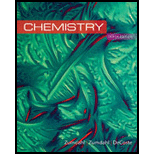
Concept explainers
(a)
Interpretation: The structures for the products of the given oxidation reactions of alcohols are to be drawn.
Concept introduction: Alcohols are oxidized to either
To determine: The structure for the product of the given oxidation reaction of alcohol.
(b)
Interpretation: The structures for the products of the given oxidation reactions of alcohols are to be drawn.
Concept introduction: Alcohols are oxidized to either aldehyde or carboxylic acids depending upon the reaction condition. When the formation of carboxylic acids is required, primary alcohol is first oxidizing to aldehyde which is then further oxidizes to give carboxylic acids. Secondary alcohols can be oxidized into ketones and tertiary alcohols do not undergo this type of oxidation.
To determine: The structure for the product of the given oxidation reaction of alcohol.
(c)
Interpretation: The structures for the products of the given oxidation reactions of alcohols are to be drawn.
Concept introduction: Alcohols are oxidized to either aldehyde or carboxylic acids depending upon the reaction condition. When the formation of carboxylic acids is required, primary alcohol is first oxidizing to aldehyde which is then further oxidizes to give carboxylic acids. Secondary alcohols can be oxidized into ketones and tertiary alcohols do not undergo this type of oxidation.
To determine: The structure for the product of the given oxidation reaction of alcohol.
(d)
Interpretation: The structures for the products of the given oxidation reactions of alcohols are to be drawn.
Concept introduction: Alcohols are oxidized to either aldehyde or carboxylic acids depending upon the reaction condition. When the formation of carboxylic acids is required, primary alcohol is first oxidizing to aldehyde which is then further oxidizes to give carboxylic acids. Secondary alcohols can be oxidized into ketones and tertiary alcohols do not undergo this type of oxidation.
To determine: The structure for the product of the given oxidation reaction of alcohol.
(e)
Interpretation: The structures for the products of the given oxidation reactions of alcohols are to be drawn.
Concept introduction: Alcohols are oxidized to either aldehyde or carboxylic acids depending upon the reaction condition. When the formation of carboxylic acids is required, primary alcohol is first oxidizing to aldehyde which is then further oxidizes to give carboxylic acids. Secondary alcohols can be oxidized into ketones and tertiary alcohols do not undergo this type of oxidation.
To determine: The structure for the product of the given oxidation reaction of alcohol.
(f)
Interpretation: The structures for the products of the given oxidation reactions of alcohols are to be drawn.
Concept introduction: Alcohols are oxidized to either aldehyde or carboxylic acids depending upon the reaction condition. When the formation of carboxylic acids is required, primary alcohol is first oxidizing to aldehyde which is then further oxidizes to give carboxylic acids. Secondary alcohols can be oxidized into ketones and tertiary alcohols do not undergo this type of oxidation.
To determine: The structure for the product of the given oxidation reaction of alcohol.
Want to see the full answer?
Check out a sample textbook solution
Chapter 22 Solutions
Chemistry
- Can I get help on drawing my arrowsarrow_forwardCan I get helpp drawing my arrowsarrow_forwardWhich of the m/z values corresponds to the base peak in the mass spectrum shown? 100 80 A. 45 B. 44 C. 29 D. 15 Intensity 20 0 10 20 30 40 B- m/z -8 50 E. 30 Which of the m/z values correspond to the molecular ion for the compound shown? A. 18 B. 82 OH C. 100 D. 102 E. 103arrow_forward
- Please explain how to calculate the pH.arrow_forwardI'm having trouble with converting lewis diagrams into VSEPR diagrams. I currently have this example of C2BrCl3 which I want to turn into a lewis structure, but I'm not sure what steps I need to do in order to do so. I have the table written down, however, there's two central atoms so what would I do? There seems to be 4 electron domains on the carbon atom and no lone pairs so it would seem like this shape would be tetrahedral. Here's what I have now. Thanks!arrow_forwardWe discussed the solid phase resin using in peptide synthesis. Provide a mechanism, for its formation. DRAW THE MECHANISM.arrow_forward
 World of Chemistry, 3rd editionChemistryISBN:9781133109655Author:Steven S. Zumdahl, Susan L. Zumdahl, Donald J. DeCostePublisher:Brooks / Cole / Cengage Learning
World of Chemistry, 3rd editionChemistryISBN:9781133109655Author:Steven S. Zumdahl, Susan L. Zumdahl, Donald J. DeCostePublisher:Brooks / Cole / Cengage Learning Chemistry: Principles and PracticeChemistryISBN:9780534420123Author:Daniel L. Reger, Scott R. Goode, David W. Ball, Edward MercerPublisher:Cengage Learning
Chemistry: Principles and PracticeChemistryISBN:9780534420123Author:Daniel L. Reger, Scott R. Goode, David W. Ball, Edward MercerPublisher:Cengage Learning ChemistryChemistryISBN:9781305957404Author:Steven S. Zumdahl, Susan A. Zumdahl, Donald J. DeCostePublisher:Cengage Learning
ChemistryChemistryISBN:9781305957404Author:Steven S. Zumdahl, Susan A. Zumdahl, Donald J. DeCostePublisher:Cengage Learning Chemistry: An Atoms First ApproachChemistryISBN:9781305079243Author:Steven S. Zumdahl, Susan A. ZumdahlPublisher:Cengage Learning
Chemistry: An Atoms First ApproachChemistryISBN:9781305079243Author:Steven S. Zumdahl, Susan A. ZumdahlPublisher:Cengage Learning
 Chemistry: The Molecular ScienceChemistryISBN:9781285199047Author:John W. Moore, Conrad L. StanitskiPublisher:Cengage Learning
Chemistry: The Molecular ScienceChemistryISBN:9781285199047Author:John W. Moore, Conrad L. StanitskiPublisher:Cengage Learning





